#baile átha cliath
Explore tagged Tumblr posts
Text

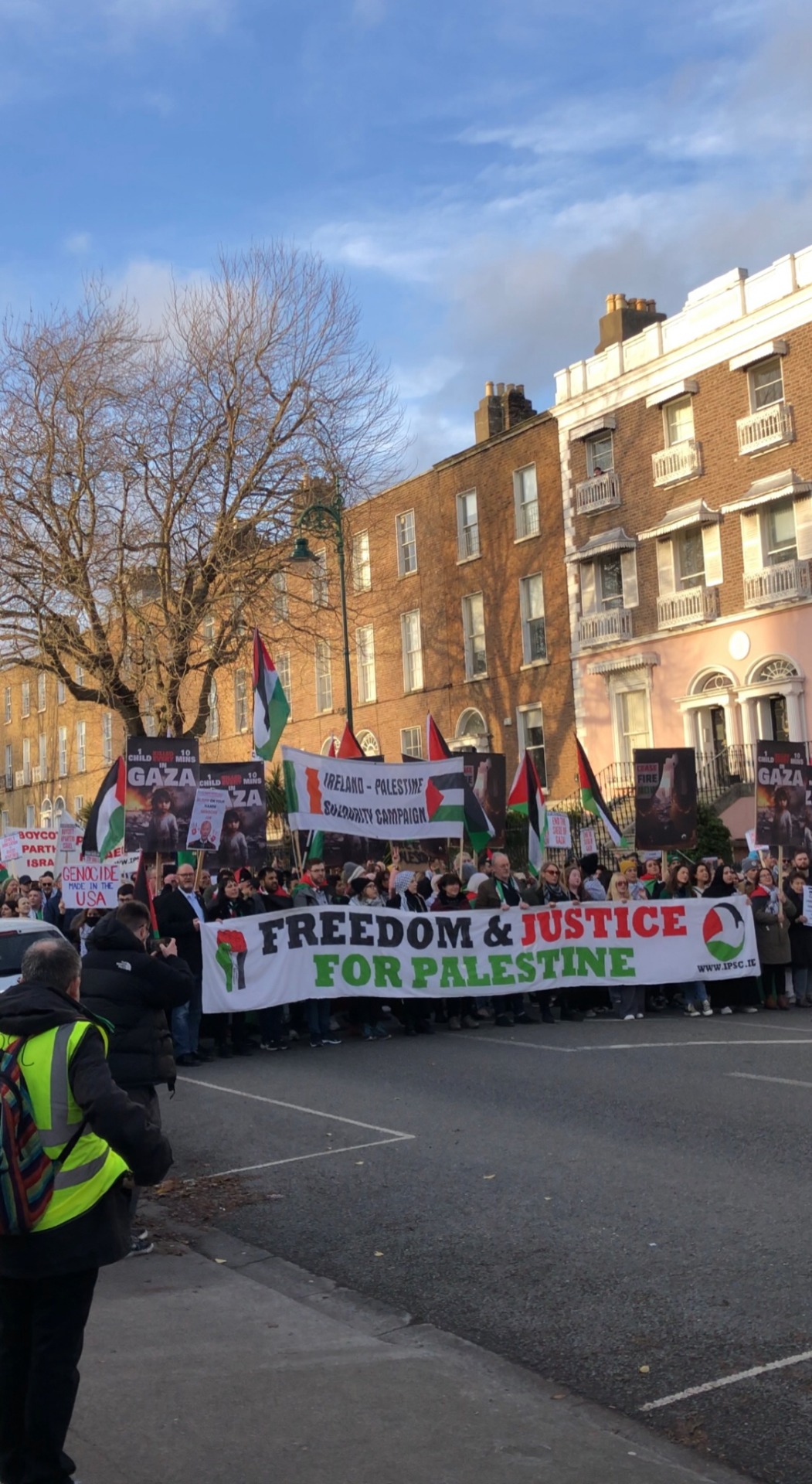


Free Palestine protest outside US Embassy in Ballsbridge, Dublin (Santa included)
🇵🇸 🍉🎅🏼
Dublin, Ireland
#free palestine#free gaza#free west bank#us embassy#Dublin#Baile Átha Cliath#ireland#éire#Palestine#gaza#West Bank#ceasefire#ceasefire now#saoirse don phalaistín
176 notes
·
View notes
Text
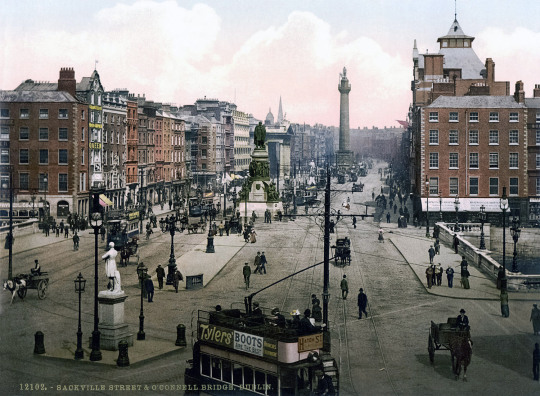
🇮🇪 📷 Sackville Street and O'Connell Bridge in Dublin, a.k.a. Baile Átha Cliath, Ireland - a photochrom print from the 1890s
#Europe#vintage#photography#Europa#Ireland#Irish#irish history#dublin#Baile Átha Cliath#cityscape#nostalgia#architecture#foto
12 notes
·
View notes
Text

Dublin / Baile Átha Cliath, Ireland 🇮🇪 - 📷 The River Liffey and Samuel Beckett Bridge at the Blue Hour
#Dublin#Baile Átha Cliath#Ireland#Éire#Seeing Europe#photo#photography#travel#Europe#travel photography#foto#fotografie#photos#Europa#city#cityscape#architecture#skyline#blue hour#Liffey#bridge#Modern Architecture#river#Night Photography#irish
10 notes
·
View notes
Video
PwC & Salesforce [IMG_2945] by Kesara Rathnayake Via Flickr: Baile Átha Cliath, Éire Dublin, Ireland
#Dublin#Ireland#Éire#Baile Átha Cliath#River Liffey#An Life#building#buildings#architecture#foto#photo#photography#travel#2024#travel photography#night#night photography#light#water#reflection#reflections#canon#50mm#nifty fifty#bridge#pwc#salesforce#long exposure#lights#city
3 notes
·
View notes
Text
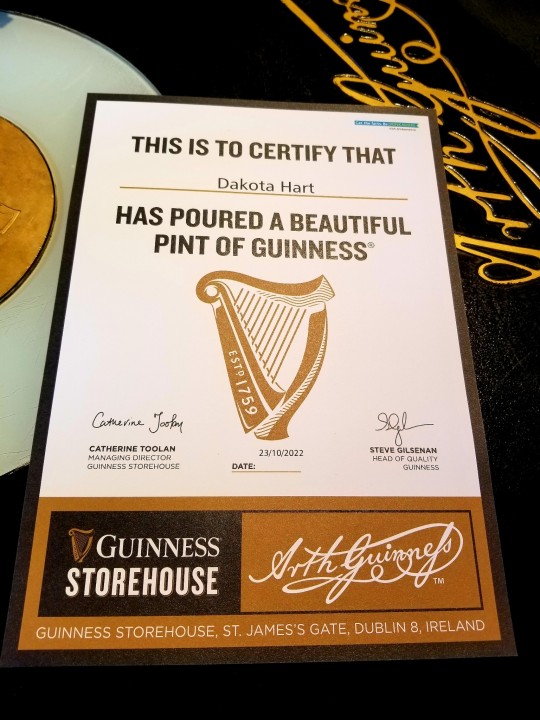

Guinness Storehouse, St. James's Gate, Dublin, Ireland
#Guinness Storehouse#Guinness#storehouse#Guinness beer#Guinness Draught#perfect pour#Dublin#Ireland#St. James's Gate#Baile Átha Cliath#Emarald Isle#Erin go Bragh#beer#stout#Guinness Stout#pints#pint
13 notes
·
View notes
Text
ba mhaith liom níos mó rudaí a rá as gaeilge anseo. like cén fath ní rinne mé ealaín faoi mo theanga dúchasach riamh.... bíonn mo chairde i gcónaí ag labhairt as gaeilge tríd an lae agus feicim daoine éireannach ar tumblr ag déanamh an rud is chéanna
39 notes
·
View notes
Text
little bits of irish history for curious hozier fans: street signs edition
Do you love the song Butchered Tongue? Pay attention to these lines here:

So, may I draw your attention to the The Official Languages Act 2003 (Section 9) Regulations 2008 (S.I. No. 391 of 2008).
ok stay with me
In 2008, the Irish government passed legislation that made it mandatory for road signs in Ireland to have both Irish (Gaeilge) AND English names on them (or, in Gaeltacht areas where Gaeilge is still the first language, only in Irish). Here’s an example:
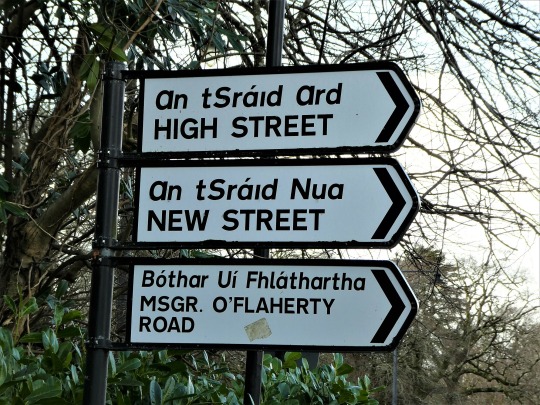
The Irish, or Gaeilge, is always above the English and italicised. This is because that while Gaeilge and English are both official languages of Ireland, Gaeilge is the ‘first’ official language
However, while it was technically only legislated in 2008, bilingual road sings in Ireland had been extremely common for decades prior to it officially being made law. In fact, the first bilingual signs date back to the early 20th century - before our independence from Britain!
In Tom Spalding’s book Layers: The Design, History and Meaning of Public Street Signage in Cork and Other Irish Cities, he found that the first recorded bilingual street sign was in Blackrock, Dublin (An Charraig Dhubh, Baile Átha Cliath). Their local council in 1901 rolled out yellow and black bilingual road sings as part of the Gaelic Revival.
The Gaeilc Revical was a period of time in Irish history that saw a huge resurgence of Gaelic art, sport, and language. Literature was written by Irish people about Irish history, current affairs, and folklore. Traditional Irish music was learned and played again. Gaelic games (Gaelic football and Hurling) spread across the country. And Gaeilge, our language, was to experience an incredible revival.
Despite Ireland’s long colonial history, Gaeilge actually remained the majority tongue until the early 19th century. However, a combination of teachers beating children for speaking it at school, the genocide of the famine wiping out mainly poorer communities more likely to speak Gaeilge, and the knowledge that speaking English unfortunately provided more opportunities than Gaeilge, the language was almost killed off. (This is shown most clearly after the 1800 Act of Union that meant Ireland was ruled directly from London, with no parliament in Dublin).
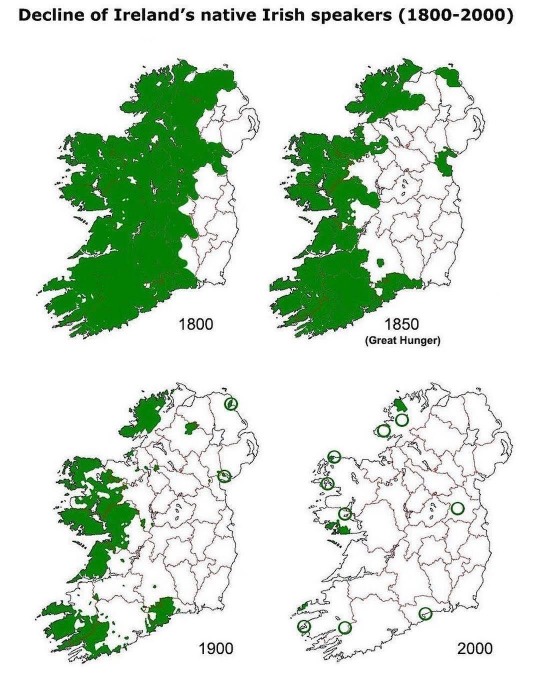
Although these maps make for grim viewing, Irish is so very far from dead. Our children learn it from the ages of 4-18 in school (though I believe it can and should be taught better, but I digress). Gaeltacht communities are still going strong particularly in the west of the country. There are more Irish-language schools (gaelscoileanna) than ever before.
And every day as we pass by road signs that display Gaeilge proudly, it is as a result of decades, centuries of people refusing to stop speaking our mother tongue despite incredible violence.
I am far from a fluent Irish speaker, despite my 14 years of learning the language in school. But what Gaeilge I have, I have proudly.

(The work isn’t over, however. I do not feel knowledgeable enough to speak on Northern Irish efforts to implement more widespread bilingual signage but anyone who wishes to share some info please do!!)
6K notes
·
View notes
Text

Julio Le Parc, Continuel-mobil Argent, (aluminium), 1967 [Áras Nua-Ealaíne na hÉireann / Irish Museum of Modern Art (IMMA), Baile Átha Cliath / Dublin. © Julio Le Parc]
#art#geometry#pattern#structure#kinetic sculpture#julio le parc#imma#irish museum of modern art#1960s
68 notes
·
View notes
Note
They are I love going
have u ever gone to the wild lights at Dublin zoo? I like going to it
Yes I have like 3 years ago though:p
#and yes dublin !!!!#baile átha cliath !!!#i genuinely cant tell if u live there r not but u made it seem like u do >_<
9 notes
·
View notes
Text

🇮🇪 📷 A student with her bike in front of the prestigious Trinity College in Baile Átha Cliath, also known as Dublin. Captured by Willem van de Poll during his stay in Ireland in 1946.
#Willem van de Poll#Baile Átha Cliath#Dublin#Éire#Ireland#bike#bikes#bicycling#Fascinating Europe#Europa#Europe#Architectural Revival#heritage#black and white#BW#black and white photo#vintage#photography#photo#foto#fotografie#photos#cityscape#street photography#old views#European heritage#1940s#20th century#biking#old photo
10 notes
·
View notes
Video
Samuel Beckett Bridge [IMG_2943] by Kesara Rathnayake Via Flickr: Baile Átha Cliath, Éire Dublin, Ireland
#Dublin#Ireland#Éire#Baile Átha Cliath#River Liffey#An Life#Samuel Beckett Bridge#building#buildings#architecture#foto#photo#photography#travel#2024#travel photography#night#night photography#light#water#reflection#reflections#canon#50mm#nifty fifty#bridge#mono#monochrome#B&W#Black & White
2 notes
·
View notes
Text

Éire agus Baile Átha Cliath/Ireland and Dublin aka Éire and his favourite child(/j)
#countryhumans#countryhumans ireland#countryhumans art#Statehumans#Dublin is just happy to be there#Also Éire is holding a shillelagh#It’s a bit hard to see#It’s so funny seeing Éire not be the short one#All his children are shorter than him#Well not all but the counties and N.I are
6 notes
·
View notes
Note
[D'Ainm Iomlán]
[D'Sheoladh]
[Dáta an Lae Inniu]
[Ainm Iomlán an TD], T.D.,
Dáil Éireann
Teach Laighean
Baile Átha Cliath 2
A [Céad Ainm an TD], a chara,
Tá súil agam go bhfuil tú go maith. Mar shaoránach atá an-imníoch faoin mhéid atá ag titim amach sa Mheánoirthear faoi láthair, ba mhaith liom mo chuid imní a léiriú faoi cheist atá fíorthábhachtach go domhanda agus go morálta: cuir i bhfeidhm Choinbhinsiúin na Ginéive.
Tá sé soiléir go bhfuil Iosrael ag sárú Airteagail 54 de Choinbhinsiúin na Ginéive, go háirithe maidir le cosaint an phobail shibhialta i nGaza.
Ba chóir d'Éirinn - tír a bhfuil traidisiún láidir aici maidir le cosaint chearta an duine agus an dlí idirnáisiúnta - seasamh láidir a thógáil ar an cheist seo agus a chinntiú go gcloíonn gach náisiún le coinbhinsiúin na Ginéive agus le conarthaí idirnáisiúnta.
Iarraim go measúil ort:
• Ceist ar sháruithe ar chearta daonna agus ar dhlíthe idirnáisiúnta a ardú i nDáil Éireann, le béim ar fhreagracht Éireann chun seasamh le agus cosaint a thabhairt do phrionsabail Choinbhinsiúin na Ginéive.
• Comhoibriú le heagraíochtaí idirnáisiúnta, go háirithe leis na Náisiúin Aontaithe, chun fhiosrúcháin chuimsitheacha a dhéanamh ar líomhaintí maidir le sáruithe atá déanta ag Iosrael ar an dlí idirnáisiúnta.
• Tacú le hiarrachtaí taidhleoireachta chun a chinntiú go gcloíonn gach páirtí sa choimhlint Iosraelach-Palaistíneach le Coinbhinsiúin na Ginéive.
Creidim go bhféadfadh le hÉirinn ról lárnach a imirt i gcur chun cinn na síochána agus seasamh leis an dlí idirnáisiúnta. Iarraim ort do ghlór mar ionadaí tofa a úsáid trí seasamh leis na luachanna uilíocha seo agus iad a chosaint.
Tá mé buíoch as an mhéid atá déanta agat go dtí seo le haird a tharraingt ar an t-éagóir atá a déanamh ar mhuintir na Pailistine.
Le meas,
[D'Ainm Iomlán]
Go raibh maith agat!
26 notes
·
View notes









![Samuel Beckett Bridge [IMG_2943]](https://live.staticflickr.com/65535/54177309304_972aee412d_b.jpg)








